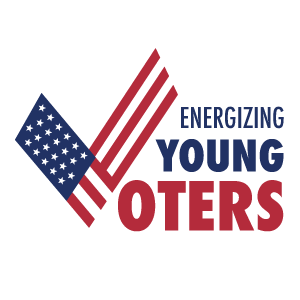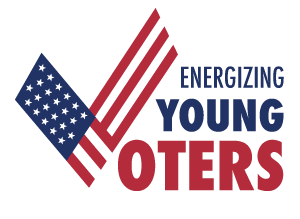What We Do
Energizing Young Voters, an initiative of the League of Women Voters, envisions a democracy where every person has the desire, the right, the knowledge and the confidence to participate.
About Energizing Young Voters
The suite of programs from the nonpartisan League of Women Voters and its partners motivate and equip students and young adults to vote and take action.

What We Do
Our free, non-partisan, educational experiences and leadership opportunities help turn students into citizens and reach our two major goals: Empowering young voters and defending democracy.
Youth Opportunities
Join a diverse group by age (18-29), gender, ethnicity/race, and education type. Set direction and policy for Energizing Young Voters and make a difference in your community! Volunteer and earn service points for school and community organizations
Classroom Lessons
Energizing Young Voters offers a suite of programs from the nonpartisan League of Women Voters and its partners designed to create a new generation of lifelong, active voters. Fighting for the Vote and Fighting for Change lessons help middle school through college-age students reach the League goals of empowering voters and defending democracy.
Guest Classroom Speaker
Our menu of interactive, in-school, or virtual lessons, can be delivered either by League-trained facilitators or the classroom teacher. Use our contact form to learn more or schedule a presentation that motivates and equips students and young adults to vote and take action.
F.A.Q.
Common Questions
Who created Energizing Young Voters?
The League of Women Voters of Southern Monmouth County developed Energizing Young Voters. The program began as Fighting for the Vote, a single lesson in which students create a physical timeline of suffrage as the story is told. A second lesson was added about voter turnout. The power of both created the intention to vote among 18-29 year olds to a degree far beyond what was anticipated. From that flagship lesson, new curricula evolved with the goal of helping to remove any impediments to voting for this age group. The name also reflects the broader purpose.
Why is the program nonpartisan?
We are connected to the League of Women Voters, a nation-wide, non-partisan organization. Like the League, we do not take positions on candidates or political parties and design our lessons accordingly. The League does take positions on issues in order to further their goal of defending democracy. We, on the other hand, are issue agnostic in order to better serve our schools. Our goal is to develop critical thinking skills which help young people make considered choices about issues of importance to them from their own cultural perspectives and learn to talk across the political divide with civility.
How much time do I need to run it?
Each of our voting modules, both in-person and remote, is designed for a 40-minute class period. In schools using block scheduling, an 80-minute block is perfect for presentations of Module 1 and 2 which build on one another. Module 3 can be taught separately. Our culminating activity, Module 4, because several classes participate, runs approximately a half-day, though each class participates in the actual voting day for approximately 30 minutes. The teacher is responsible for “registering” students and discussing the sample ballot prior to the culminating experience. This is done at the teachers’ convenience.
The lessons to reach the second League goal, defending democracy, follow the same time limitations guidelines.
Who is the intended audience?
Our lessons can be taught from middle school through university level, depending on the lesson. In middle school, both Fighting for the Vote: The Suffrage Timeline and the voting experience itself are appropriate when students are introduced to the voting machine. A condensed, combined version of What’s Your Issue and I AM the change is also available for middle school classes.
High school and college-age students benefit from all modules. In a slightly modified form, citizenship preparation classes benefited from Fighting for the Vote. Other adult groups, particularly when Covid required the use of mail-in ballots that were unfamiliar to many older Americans, benefitted from our Student Advocate Toolkit.
Is there a limit to how many students I can run it with?
What are the technology requirements?
Does the curriculum comply with any core standards?
In NJ, a new law passed in 2022 (Laura Wooten’s Law) requires middle schools to offer one semester of discrete civics education sometime during the middle school years. The Center for Civic Education at Rutgers University offers a broad range of curriculum suggestions (not mandates) on their website. Schools are free to meet the standards in the way they deem best for their district.
Energizing Young Voters’ lessons are aligned with the NJ Middle School Civics Standards for Grade 8, particularly with Part 4 of NJ Middle School Civics Standards shown in the matchup here. Our lessons are also aligned with the State Social Studies Civics Standards for Grade 8 and Grade 12.
At the high school level, civics education is usually integrated into courses such as American History, American Government, and elective courses. Our lessons help answer the guiding questions for civics in the NJ Civics, Government, and Human Rights standards. These are:
- How do citizens…good?
- How have economic…human dignity?
How much does the curriculum cost?
How do I sign up for a presentation?
How do I volunteer?
Fill out our contact form and let us know what you are interested in doing and what skills you have.
Get in Touch. Get Involved.
Have a question, want to request a speaker or get involved? Please send us an email and we will get back to you as soon as possible.
"*" indicates required fields

